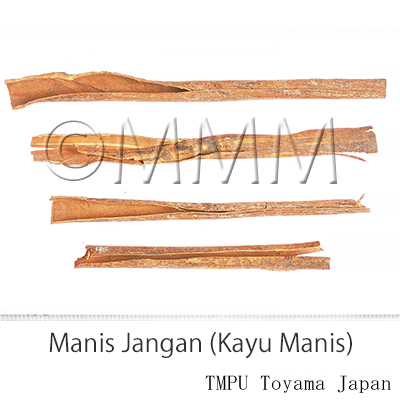Crude drug sample data base
※Click on the image to enlarge it.
The capital city, provincial capital city or the representative
location of its administrative area is indicated.
location of its administrative area is indicated.
Production area information
https://ethmed.toyama-wakan.net/img/pin_san.png
-7.7955798
110.36948959999995
Collection information
Republic of Indonesia,Special Region of Yogyakarta
https://ethmed.toyama-wakan.net/img/pin_nyu.png
Scientific information data base
| Crude drug name | Indonesian name, English name | Kayu manis, Indonesian cassia, Padang cassia, Cassia vera | ||||
|---|---|---|---|---|---|---|
| Synonyms | Keningar | |||||
| crude drug image |
| |||||
| Original plant name | Cinnamomum burmannii Nees ex Bl. | |||||
| Family name | Lauraceae | |||||
| Used part | Bark | |||||
| Distribution area | It is distributed in Malaysia. It is cultivated in Indonesia (Java, Sumatera) and Padang (West Sumatra) is an important production area. In Java it scattered in the forests from 1000 up to 1500 m altitude. It is cultivated in Mount Tengger, Mount Merbabu and Ragajembangan in Java. The harvested area in Indonesia in 1998 was estimated by FAO at 60,000 ha [201]. | |||||
| Description | It is aromatic and the characteristic odour and flavour properties are determined by the constituents of the steam-volatile aromatic oils. The bark surface is smooth, rarely fissured, lenticellate, grey-brown to reddish-brown, inner bark granular, pale brown to pink or reddish-brown, with a strong aromatic smell. The plant is a shrub or small tree up to15 m tall. Leaves subopposite, blade oblong-elliptical to lanceolate, pale red and finely hairy when young, when older glabrous and glossy green above, glaucous pruinose below. Inflorescence a short axillary raceme. Berry ovoid, about 1 cm long [204]. | |||||
| Drug effect | Hot, a little bit sweet, warming [231]. | |||||
| Frequency in use | Abundant | |||||
| Common uses | The bark is commonly used as spice for flavouring foods at the household level and also in industries [204]. | |||||
| Pharmacological effect | Study on the mechanism-based inhibition of cytochrome P 450 3 AA showed that Cinnamomum burmani showed more than 30% increase of cytochrome P 450 3 AA inhibition [PMID:16414224]. Study on the anti microbial activity of o-methoxycinnamaldehyde has been conducted. It was shown that the compound inhibits the growth and toxin production of mycotoxin-producing fungi, Aspergillus parasiticus, Aspergillus flavus, Aspergillus ochraceus and Aspergillus versicolor. It also displayed a strong inhibitory effect on the growth of dermatophytoses [PMID:708030]. | |||||
| Medical system | Indonesian medicine (Jamu) | |||||
| Traditional usage | It is used to treat abdominal discomfort and mouth ulcer. It is also used as an appetite stimulant, treating diarrhoea/diarrhea and rheumatism [207, 231]. | |||||
| Formulation | 1) Diarrhea: 3 grams of cinnamon bark, 2 grams of Helicteres isora fruits, 2 grams of Usnea misaminensis (Usnea sp.) thallus, 8 grams of fresh Kaempferia galanga rhizome, 3 grams of Coriandrum sativum fruits, 2 grams of Nigella sativa seeds, 10 grams of Zingiber aromaticum, 2 grams of Alyxia reinwardtii barks, 2 grams of Parkia biglobosa seeds. Mixed all ingredients, ground to make a poultice by adding water. Apply the poultice on the stomach and cover with cloth [231]. | |||||
| References | Reference book Tips! | [201] K. Heyne, Tumbuhan Berguna Indonesia, Vols. 1-4, 1987. Diedarkan Oleh Koperasi Karyawan Departemen Kehutanan, Jakarta, Indonesia. Vol. 2, pp 795-799. [204] de Guzman, C.C. and Siemonsma, J.S. (Editors), 1999. Plant Resources of South-East Asia No. 13 Species. Backhuys Publishers, Leiden, Netherlands. pp 95-99. [207] Badan Penelitian Dan Pengembangan Kesehatan and Departemen Kesehatan, Kesejahteraan Sosial Ri. Vols. 1-5, Inventaris Tanaman Obat Indonesia, Jakarta, Indonesia. Vol. 1, Part 1 (2000), pp 67-68. [231] Soedibyo, Mooryati: Alam Sumber Kesehatan: Manfaat dan Kegunaan (Natural resources for health. Benefits and uses). Balai Pustaka. 1998. pp 193-194. | ||||
| Research paper | 1. Subehan, Usia T, Iwata H, Kadota S, Tezuka Y. Mechanism-based inhibition of CYP3A4 and CYP2D6 by Indonesian medicinal plants. J Ethnopharmacol., 24;105(3):449-55, 2006. (PMID: 16414224) 2. Morozumi S. Isolation, purification, and antibiotic activity of o-methoxycinnamaldehyde from cinnamon. Appl Environ Microbiol., 36(4):577-83, 1978. (PMID: 708030) | |||||
| Remarks | [DNA sequence] DQ822591 Indonesian cassia is an important export product from Indonesia: during the years 1991-1994 the United States imported annually about 13,000 t quills from Indonesia, valued at about US$ 23 million [204]. | |||||
| Last renewal date | 2024/03/06 | |||||





